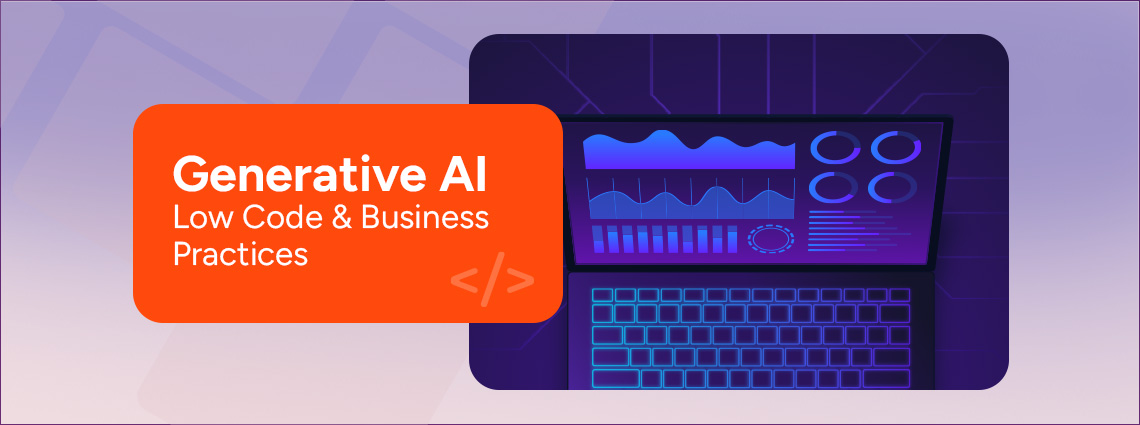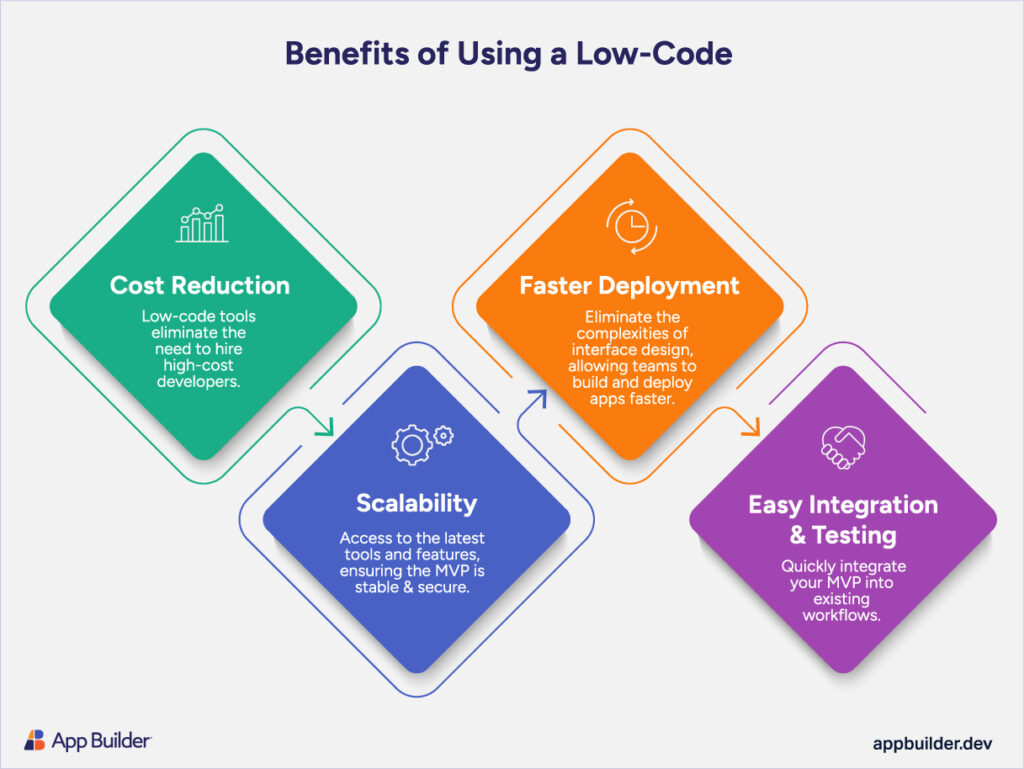

6 Steps For Building an MVP Fast With Low-Code Platforms
App Builder is a low-code platform that can provide your organization with the flexibility, security, and features you need for building an MVP quickly and at a fraction of the cost of traditional development. But how to do it step by step? Read here.
Low-code platforms can significantly accelerate the process of building an MVP (Minimum Viable Product). As most business leaders know, the faster you can launch a product, the sooner it will start to deliver results. Anything you can do to reduce development time and resources directly equates to bottom-line value, and that’s always the goal.
This article highlights the key benefits of using low-code platforms for MVP software development, outlining the necessary steps and offering tips to ensure scalability and flexibility as the product evolves.
What Is a Minimum Viable Product?
A minimum viable product is an early version of a product with enough features to demonstrate value, validate an idea, and attract early adopters. When creating apps or software, a low-code MVP is critical as it enables feedback from actual users to help the dev team leader and the team itself to iterate and improve the product. This makes the MVP crucial in agile development and an integral aspect of lean startup methodologies.
Why Is Minimum Viable Product Important?
Companies are building an MVP for several reasons:
- To bring a product to market quickly
- Gain investor buy-in
- Test the viability of the idea before fully committing to its creation
- Gain a better understanding of the audience and their pain points
- Collect feedback from actual users to improve the product before it officially launches
- Minimize risk and spending on a product that won’t go the distance
Key Benefits of Using a Low-Code App Builder for Your MVP
Few apps are developed without first building an MVP. But by the very nature of low-code platforms, building an app should be fast and straightforward. Using a low-code tool, like App Builder, is an excellent solution as it reduces MVP software development time, costs, and complexities. Teams have complete control over the development process and produce a viable result without the need for coding skills.

Here are a few benefits of using a low code.
Cost reduction
Low-code tools eliminate the need to hire high-cost developers because they can build MVP without code. Extensive coding skills are not required as the interface is drag-and-drop. Everyone works in the same environment, including designers, developers, stakeholders, providing a single source of truth during development. This reduces delays, friction, and time. And it also results in quicker time to value and massive cost reductions with less risk. But the biggest advantage here is that low-code tools actually allow more experienced developers to refocus their efforts and dedicate valuable time to more important tasks, like writing custom code.
Scalability
Platforms like App Builder provide access to the latest tools and features, ensuring the low-code MVP is stable, secure, and aligned with today’s demand-supply dynamics. MVPs must be flexible enough to scale when the app gains more users and becomes successful. Low-code tools also enable teams to launch apps with solid foundations, engaging the limitless computing power of cloud infrastructure and microservices to enable rapid scale.
Faster deployment
As WYSIWYG drag-and-drop tools, low-code platforms eliminate the complexities of interface design, allowing teams to build and deploy apps faster. Developers focus on the business logic because they are provided with the code base and theming out of the box. This happens in a fraction of the time compared to coding everything from scratch. Low-code platforms like App Builder generate code in a single click, which can instantly convert to production-ready code for today’s most popular coding languages once the MVP phase is complete.
Easy integration and testing
Drag-and-drop features of low-code app builders are not only helpful in building an MVP but also in integrating your MVP into existing workflows. This allows you to test features and see them in action right away. You can test the app alongside your current methods to see how they compare or combine multiple workflows into a single solution with just a few clicks. Connecting data sources and making changes is simple; you’ll see the results immediately.
How To Build a Minimum Viable Product with Low Code
To minimize the time spent building an MVP, map out your MVP’s function and features before your team starts building. Assuming you already have a well-defined target audience, here are six essential steps to follow when creating an MVP without coding.
1. Define core features for your low-code MVP
By definition, an MVP is a more basic version of the final product. While you may have a clear vision of where you’re headed, ensure your team chooses only the most essential features. The goal is to optimize the process for fast deployment. Developers should focus on their audience’s pain points and apply features that solve them.
2. Consider reviews and case studies
Research low-code platforms to ensure you choose the one that best suits your company’s and teams’ needs. Read reviews to understand how other users feel about it, and look for case studies showing how the app helped other organizations in your industry.
3. Select the right low-code platform
Consider the suitability of the low-code tool based on the people using it. The tool should be simple enough for your team to use. Request a demo or sign up for a trial to see the app in action before you commit.
4. Define success criteria
Understanding what success looks like is critical to the evaluation process. Again, C-level executives need to take the time to articulate expected results and KPIs. This is how the company can gauge the app’s value and quantify your team’s efforts.
5. Build MVP without code
Launch your low-code app builder and ensure programmers create the MVP using the criteria you’ve established in the planning phase. Remember, this is just a final app prototype, so keep it as simple, useful, and user-friendly as possible.
6. Launch your MVP, monitor performance, and incorporate feedback
Launching the MVP to a select group of users and early adopters is important. Request feedback from users to determine whether it meets expectations in a way that’s better than alternatives already in the market.
Top Challenges to Avoid When Building an MVP with Low Code
While there are many advantages to building apps on a low-code platform, problems can arise during development. Here are a few mistakes to avoid when building a minimum viable product.
Avoid vendor lock-ins
One of the most significant issues with low-code tools is that they lock the source code so you can’t access it when you’re ready to move past the MVP prototype phase. Changing vendors or migrating the code to another platform will be an issue if the code is locked or proprietary. Before you choose an app builder platform, understand their policies and determine whether you can maintain the app off the platform. Some vendors, like App Builder, generate standard code that works anywhere. This feature should top your list of must-haves.
Consider security risks
Some low-code platforms make security controls invisible to the user, while others prioritize transparency. While the platform will have security features built-in, you may not be able to customize the code to your specific needs. View available security documentation to ensure it aligns with your compliance standards.
Avoid adding too many features
Adding too many features doesn’t serve the purpose of an MVP. Minimum is the keyword here; include only the most critical features in your MVP iteration, as anything beyond that may distract from the primary purpose of the prototype. Focus on the basics and perfect them first before implementing everything.
Scaling Your MVP Post-Launch
The app is now up and running and you are ready to launch.
Ideally, you’ll want to introduce it to a select group of ideal users. Ensure you establish open communication and encourage them to provide feedback. You can track usage data from back-end analytics, but open dialog is preferable if you can manage it. Be responsive and demonstrate a commitment to improvement, and you’ll build a solid network of loyal users.
If the end-users approve the app and your developers have eliminated all the bugs, they are ready to move on to the next stage of development and scale your low-code MVP up to a minimum marketable product (MMP).
Scaling a software product requires adequate resources, capacity, and strong vendor relationships to ensure success. Here are a couple of considerations to inform your next steps.
Consider flexibility and integrations for futureproofing
Before scaling your app, you need a firm understanding of where the industry and the customers are headed. Your app needs to be flexible enough to accommodate more integrations and new technology to ensure you continue to meet the audience’s needs. Prioritize flexible frameworks so you can add new features and estimate your load needs to ensure you have the computing power and capacity to support demand.
Optimization, performance, and growth
Continue monitoring and ensure your team iterates and refines your app to remain viable. Performance optimization is vital to growth, as poor performance leads to frustrated users and business loss. Teams should add new features only if they align with user needs and roll them out gradually to not overwhelm or clutter the interface.
Conclusion: Launch Fast, Iterate Faster with Low-Code MVPs
App Builder is a flexible, low-code platform that can provide your organization with the flexibility, security, and features you need to design, develop, and deploy MVPs quickly, in record time, and at a fraction of the cost of traditional development.
Choosing the right low-code app builder and planning your strategy is the best way to code fast and ensure the result meets expectations.
Book a demo today to see App Builder in action.



